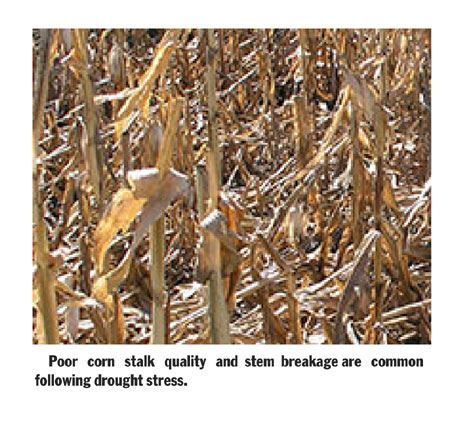Timely Harvest Important In Drought Stressed Corn
COLUMBIA, MO.
Using a yield trend line for
the past 30 years, I calculated
that corn yield for
Missouri in 2012 should be
should be about 141 bushels
per acre. The August USDA estimate
for Missouri is only 75
bushels per acre, a yield reduction
of 47 percent. Harvest has just begun, so
time will reveal the accuracy of the 2012 estimate.
Regardless, 2012 was and continues to be
one of the more challenging years for corn in
Missouri. Most Missouri farmers are understandably
disappointed in their corn yields and
cautious to sink additional expenses into the
crop.
However, timely harvest is essential to harvesting
as much of the yield as possible even if
it results in increased drying or aeration costs.
Corn stalk quality is often poor in a drought
year, and poor stalk quality leads to increased
preharvest and harvest losses. There are several
reasons for poor stalk quality in drought years,
and these reasons probably differ among fields
in 2012. Several disease-causing fungi (e.g.
charcoal rot) grow fairly well on heat and
drought stressed corn stalks. Potassium uptake
is important for stalk quality, and K uptake is
often reduced from dry soils. Stalk diameter of
drought stressed plants is smaller than normal.
Lateral cell expansion was limited because of reduced
turgor pressure. Finally, many plants
died earlier than normal and this allowed saprophytic
fungi to attack dead cells and break
down cellulose and other structural compounds.
Regardless of the reason, poor stalk quality
leads to stem breakage (Figure 1). Breakage
often occurs below the ear making is difficult to
gather ears into the combine. Recently, the remnants
of Isaac and several cold fronts have
brought rain to many parts of Missouri. In addition,
high dew points have resulted in heavy
dews and fog. Rains, dews, and fogs keep corn
stalks damp for many hours. Warm temperatures,
even mid 70s, along with damp plant tissues
stimulate fungi growth. These fungi break
down stem tissues and weaken the stalk. Even
stalks with small ears become susceptible to
breakage. Winds, especially those associated
with late summer storms, add to the breakage.

Stem breakage increases with time and harvest
delay. So, timely harvest, as soon as fields
are dry enough to withstand combine and
wagon traffic, is important to reduce harvest
losses. Harvesting a larger portion of the low
yields common this year may outweigh additional
costs often associated with an early harvest.
Δ
DR. WILLIAM WIEBOLD: Professor Agronomy,
University of Missouri